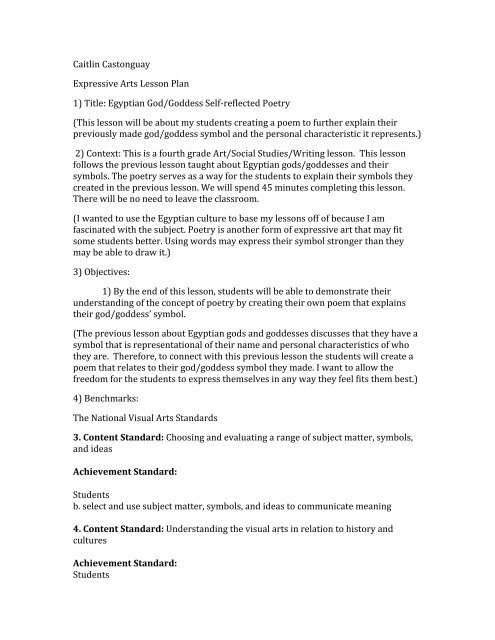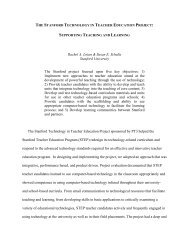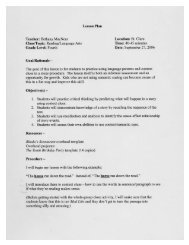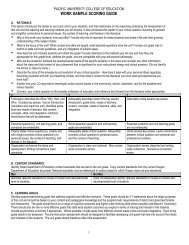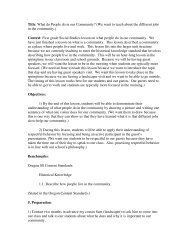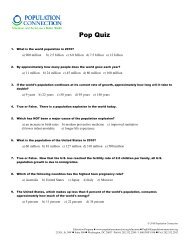Egyptian Gods-Goddesses Lesson.pdf - Early Learning Community
Egyptian Gods-Goddesses Lesson.pdf - Early Learning Community
Egyptian Gods-Goddesses Lesson.pdf - Early Learning Community
- No tags were found...
You also want an ePaper? Increase the reach of your titles
YUMPU automatically turns print PDFs into web optimized ePapers that Google loves.
Caitlin Castonguay Expressive Arts <strong>Lesson</strong> Plan 1) Title: <strong>Egyptian</strong> God/Goddess Self-‐reflected Poetry (This lesson will be about my students creating a poem to further explain their previously made god/goddess symbol and the personal characteristic it represents.) 2) Context: This is a fourth grade Art/Social Studies/Writing lesson. This lesson follows the previous lesson taught about <strong>Egyptian</strong> gods/goddesses and their symbols. The poetry serves as a way for the students to explain their symbols they created in the previous lesson. We will spend 45 minutes completing this lesson. There will be no need to leave the classroom. (I wanted to use the <strong>Egyptian</strong> culture to base my lessons off of because I am fascinated with the subject. Poetry is another form of expressive art that may fit some students better. Using words may express their symbol stronger than they may be able to draw it.) 3) Objectives: 1) By the end of this lesson, students will be able to demonstrate their understanding of the concept of poetry by creating their own poem that explains their god/goddess’ symbol. (The previous lesson about <strong>Egyptian</strong> gods and goddesses discusses that they have a symbol that is representational of their name and personal characteristics of who they are. Therefore, to connect with this previous lesson the students will create a poem that relates to their god/goddess symbol they made. I want to allow the freedom for the students to express themselves in any way they feel fits them best.) 4) Benchmarks: The National Visual Arts Standards 3. Content Standard: Choosing and evaluating a range of subject matter, symbols, and ideas Achievement Standard: Students b. select and use subject matter, symbols, and ideas to communicate meaning 4. Content Standard: Understanding the visual arts in relation to history and cultures Achievement Standard: Students
1. know that the visual arts have both a history and specific relationships to various cultures (Stated in The National Visual Art Standards) 5) Preparation: 1) Research <strong>Egyptian</strong> gods/goddesses, symbols, and meanings. http://www.ancientegypt.co.uk/gods/explore/main.html http://www.chiddingstone.kent.sch.uk/homework/egypt/gods.htm http://www.bbc.co.uk/history/ancient/egyptians/ 2) Gather paper and pencils. 3) Prepare teacher’s poem for anticipatory set. 4) Gather and print examples of different forms of poetry from the book Where the Sidewalk Ends by Shel Silverstein and Love that Dog by Sharon Creech. (This preparation builds on the previous lesson. The poem created will be representational of the goddess of laughter used in the anticipatory set of the previous lesson about <strong>Egyptian</strong> gods/goddesses and their symbols. The different examples of poems will be available for students to explore while writing their poem.) 6) <strong>Lesson</strong> Introduction/Set: Read the poem to students. (1-‐2 minutes) Raughter My gift is the ability of laughter. Whenever you feel down and you want to turn it around You can count on me I will say jokes round and round There is never a frown after. (The poem I will read will provide an oral example of how their poems can sound when they create their own. It will also be an example of how to explain their god/goddess symbol that is representational of its characteristics. After reading it, it will be placed under the document camera for the students to see.) 7) Sharing objectives: (1-‐2 minutes) Today, you are going to create your very own poem about your god/goddess symbol you created yesterday. You may write it in any form that you want. For instance, my poem that you just heard was a free form poem about the defining characteristic of my goddess of laughter.
(I am being explicit because I want the class to know what we are doing and what I expect of them.) 8) <strong>Learning</strong> activities: (30 minutes) -‐ After sharing the objective, I will read some poems from the books Where the Sidewalk Ends by Shel Silverstein and Love that Dog by Sharon Creech to provide more examples of different styles of poems. (5 mins) -‐I will ask if there are any questions. I would also do a check for understanding by asking: Can I write my poem in any style? What is my poem supposed to be about? (5 mins) -‐Once questions have been clarified, I would have the students pull out their symbols they created for inspiration and let them start working on their poems. (20 mins) -‐The poems read after the shared objective will be available to the students to read through for ideas and examples while they are writing. -‐ I will give students 10 minute, 5 minute, and 3 minute warnings of time to keep them on track and aware of when we will come back together as a class. (Using mentor texts is a great way to provide examples for students and their writing. Because I am not asking for a specific type of poem, I wanted to provide multiple examples. I also want the students to use their symbol they created previously to inspire their ideas.) 9) Differentiated <strong>Learning</strong>: 1) Process: If students cannot finish the project during our allotted time, they will be able to finish their poem during choice time or can take them home. 2) Environment: I will make sure that students have enough examples available to guide their writing. I will also make myself available for answering questions. The classroom noise level doesn’t have to be silent, but at a level that all students can work efficiently. 3) Content: The mentor texts would serve as my alternative materials for the learners. If they cannot connect with the books provided, I would allow them to search for more examples of poems online using the computers in our classroom. 4) Product: If students were stuck on describing their symbol, I would let them describe their god/goddess name instead if that made more sense. If they are overwhelmed by writing a poem, I would have them write ideas down and not worry about placing them into a poem yet.
5) Extensions: Students who finish early can add artistic details to their poem or symbol. They may also explore the poem books with a peer. (I am not expecting many students to finish early since this will be their first time experimenting with their poems. All students are capable to write a poem, especially since it has to do with a symbol they made that is unique to them. The environment space won’t be an issue, but the noise level may need to be controlled. ) 10) Closure: (10 minutes) -‐I will call students back together to discuss their experience with poem writing. -‐I will ask students if they want to volunteer and share their symbol and poem with the class. -‐We will also wrap up our discussion about <strong>Egyptian</strong> gods/goddesses. I would want students to share what they learned about <strong>Egyptian</strong> god/goddess symbols and connect that to their experience of creating their own symbol. (I am asking for volunteers because the poems may be personal and not everyone will want to share. This closure serves as a closure for both lessons because the poem lesson was the next sequential element to the symbols and gods/goddesses created in the previous lesson.) 11) Student Assessment: Students will be assessed based on the completion of their own poem about their god/goddess symbol. The poem should give the audience a better understanding of the meaning behind whatever they chose to write about. 12) Teacher Self-‐Reflection: I am confident that students will enjoy this poetry writing because it is personal and free form to themselves. There are not many requirements to the poem besides the topic of their god/goddess symbol. I am hoping that the mentor texts will be interesting to the students and provide enough examples. I would expect that students would want to share with the class because it is unique and creative to their imagination.


